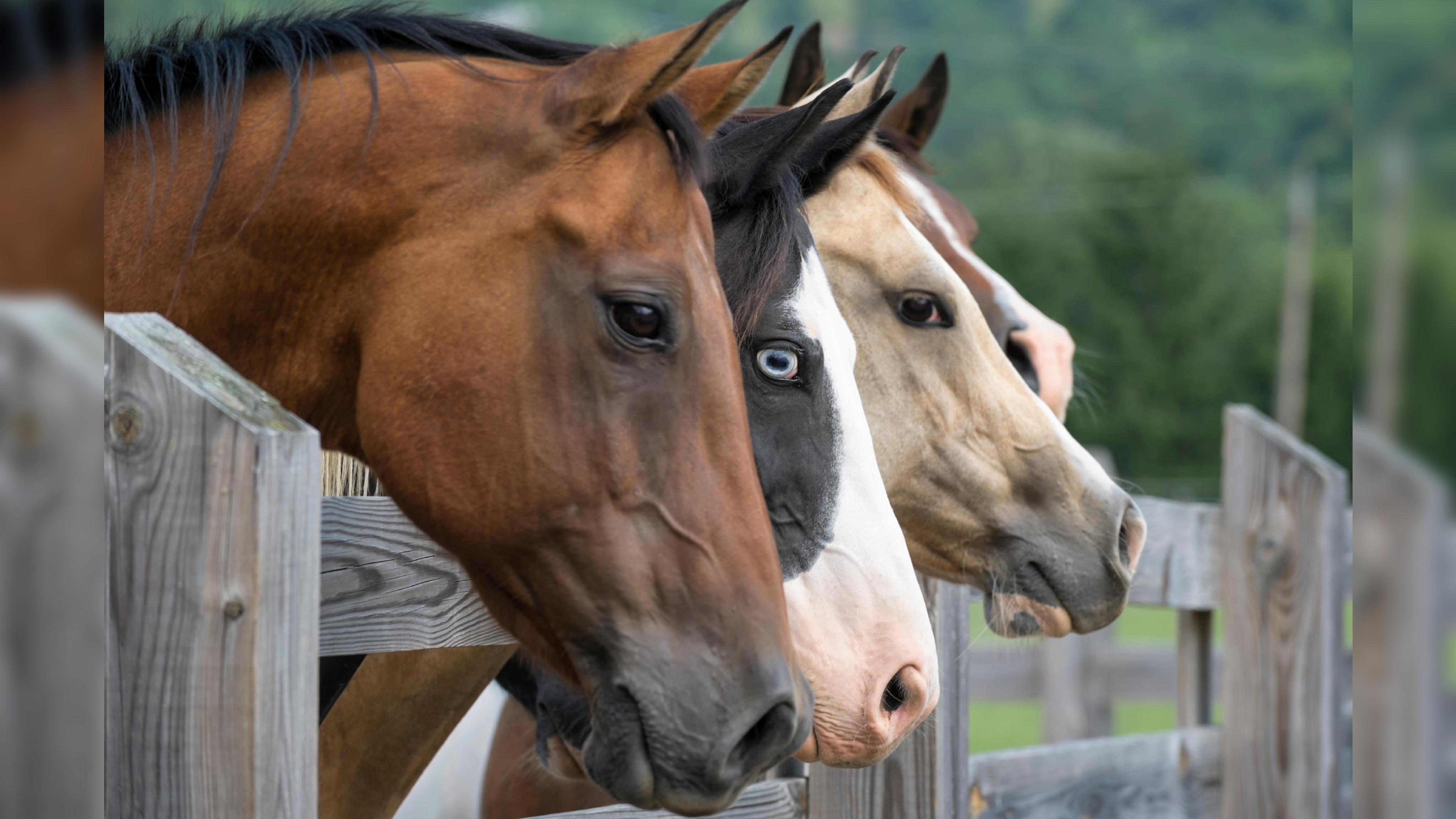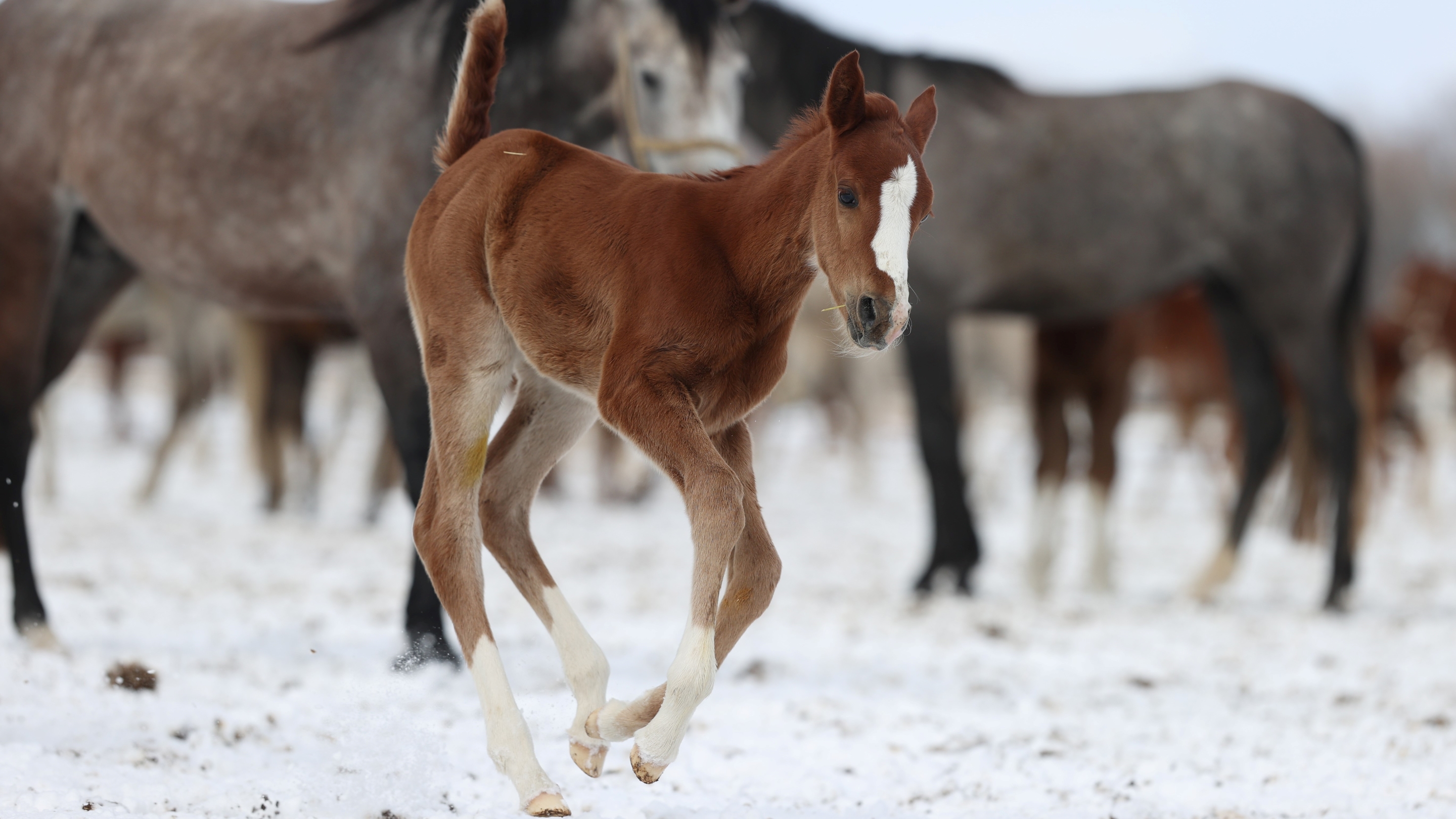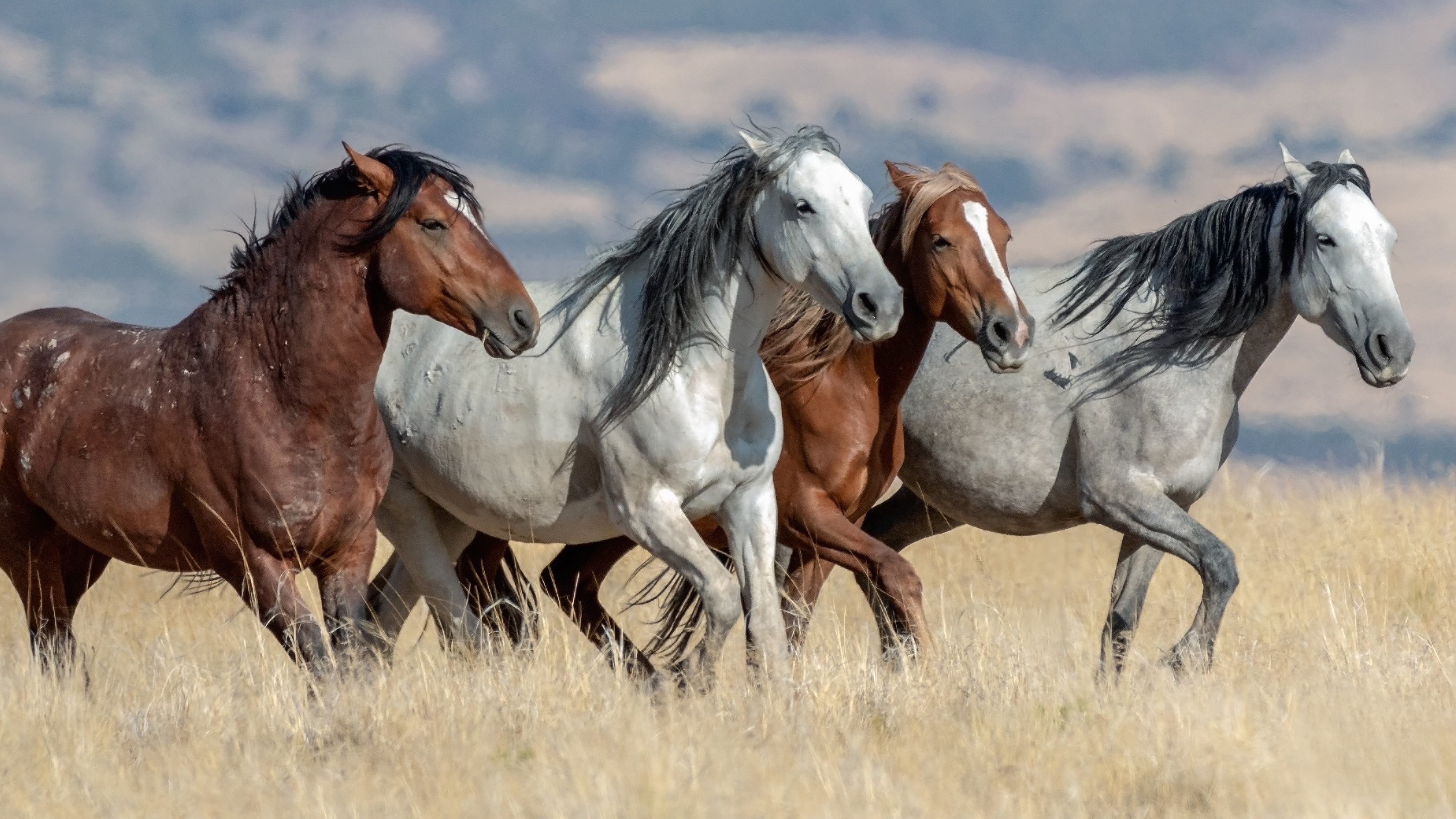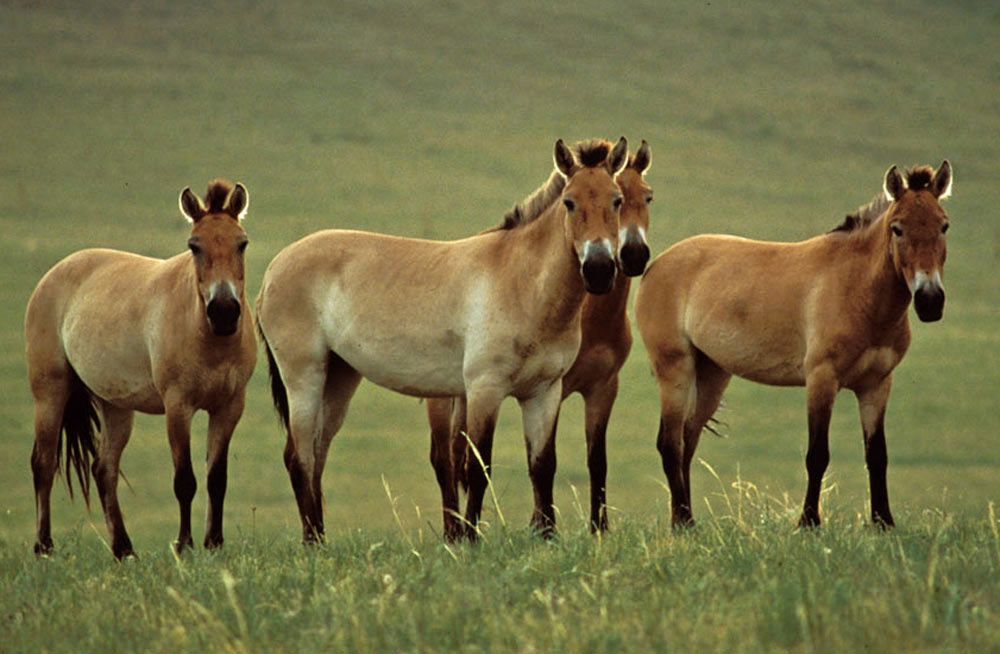Horses: Domestic, feral and wild
Horses have lived with humans for thousands of years.

Horses are hoofed mammals that have lived with humans for thousands of years. Almost all of the horses alive today are domesticated and descend from extinct wild horses. Horses have roamed the planet for about 50 million years. The earliest horses evolved in North America before spreading out to the rest of the world, although they later became extinct in North America about 10,000 years ago, Live Science previously reported.
When were horses domesticated?
All breeds of domestic horse belong to one species, Equus caballus, which includes feral populations of domestic horses living in the wild, according to the Integrated Taxonomic Information System (ITIS).
Modern horses were likely first domesticated in central Asia between 3000 and 4000 B.C., according to Oklahoma State University. However, horse DNA is relatively diverse, which suggests that horses could have been domesticated in more than one place and from several different wild populations, according to the American Museum of Natural History (AMNH).
Related: 'Ice age' horse skeleton found in Utah backyard isn't what we thought
Horses were initially kept for meat and milk, according to Oklahoma State University. They became a valuable resource for people living on the central Asian steppes, where horses are still eaten and milked today. Fermented mare's milk is a popular, alcoholic drink among the kumis people of the central Asian steppes, Live Science previously reported. As horses became more domesticated, humans have developed more uses for them, such as serving as a means of transportation, as companion animals and as a source of entertainment in the form of horse racing. Today, horses can be found in the care of humans all over the Earth.
Horses are social animals and are known for bonding with members of their herd and for following the most dominant horses in the herd, according to AMNH. In captivity, and in the absence of a herd, horses have a tendency to bond with people and learn to follow their instructions. This enables humans to more easily train horses to be ridden. Similar to other domestic animals, being led by humans has been encouraged through multiple generations of breeding.
The only horses alive today that aren't considered domesticated are Przewalski's horses, or takhi, in central Asia. ITIS lists these wild horses as a separate species named Equus przewalskii. However, some experts categorize domesticated horses and Prezewalski's horses as subspecies of the same species, called Equus ferus caballus and Equus ferus przewalskii, respectively. Either way, Przewalski's horses are distinct from domestic horses, although their evolutionary origins are debated within the scientific community.
How big are horses?
Horses are muscular animals with a long tail made up of coarse hair, a long, thick neck draped with a mane down the midline, and an elongated head and skull. Humans have created hundreds of different horse breeds through selective breeding, which has resulted in many different horse coat colors, including chestnut, gold with a white mane and tail (palomino), spotted, completely black and more, according to Oklahoma State University.
Measured from the ground to the tops of their shoulders, horses typically range between 2 feet 6 inches (76 centimeters) and 5 feet 9 inches (175 cm) tall, and weigh between 120 lbs. (54 kilograms) and 2,200 lbs. (1,000 kg), according to National Geographic. However, it's not unusual for horses to be smaller or larger than average.
Kingdom: Animalia
Phylum: Chordata
Class: Mammalia
Order: Perissodactyla
Family: Equidae
Genus: Equus
Species: caballus
Source: ITIS
Guinness World Records considers the tallest living horse to be a Belgian horse named Big Jake that's nearly 7 feet tall (82.8 inches, or 210 cm, to be exact). The Belgian breed is known for being one of the strongest and most powerful horse breeds in the world. The tallest horse to have ever lived was a shire horse named Sampson, or Mammoth, who in 1850 was measured to be about 7 feet 2 inches tall (86.2 inches or 219 cm), according to Guinness World Records.
At the other end of the scale are ponies and miniature horses. A pony is an adult horse that is shorter than 4 feet 10 inches (147 cm), according to Encyclopedia Britannica. A miniature horse is even smaller, at less than 3 feet 2 inches (97 cm) tall. The shortest horse ever recorded by Guinness World Records was a miniature horse named Thumbelina, who was measured to be just 17.5 inches (44.5 cm) tall before she died in 2018.
How fast can a horse run?

Horses have four main movement patterns, called gaits: walk, trot (a little faster than walking), canter (faster than a trot) and gallop (a horse's fastest gait). The average domestic horse can gallop at a speed of about 30 mph (48 km/h), but horses have been clocked at speeds of over 40 mph (64 km/h), according to AMNH.
Related: Thoroughbred racehorses get speed from just a few ancestors
Guinness World Records recognizes 44 mph (70.8 km/h) as being the fastest speed reached by a racehorse. This was achieved by a Thoroughbred named Winning Brew in 2008 over a quarter-mile distance. However, the American quarter horse is often considered to be the fastest horse breed, and the American Quarter Horse Association states these horses have reached speeds of up to 55 mph (88.5 km/h).
Horses are ungulates, which are mammals that have hooves, according to the Florida Museum of Natural History. Horses have evolved to have a single toe on each foot encased by a hard hoof. Hooves are made of keratin, which is the same protein that makes human fingernails, according to Encyclopaedia Britannica. Like fingernails, hooves never stop growing and need to be trimmed. Horse owners often attach metal horseshoes to the bottom of their horse's hooves to protect the hooves from wear.
What do horses eat?
Horses are herbivores, and their diet consists mainly of tough grasses. Large, flat teeth called incisors at the front of the horse's mouth help it to grab and rip grasses from the ground, which the horse then grinds with the molars and premolars that line each side of its jaw, according to the University of Illinois College of Veterinary Medicine.
Horses have the smallest stomach relative to body size of any domesticated animal, according to Iowa State University. A horse's low-capacity stomach is suited to small but frequent meals. Most nutrients are absorbed as food passes through the small intestines and into the hindgut, which includes the cecum, large colon and small colon, where it is fermented by bacteria. The Humane Society suggests that a healthy horse should be fed 1% to 2% of its body weight in grass or hay every day.
The life of a horse

An adult male horse is called a stallion, and an adult female horse is called a mare. If a male horse is castrated by humans, it becomes known as a gelding. In the wild, horse herds are led by a dominant mare, while a single, dominant stallion typically guards the rear of the group from predators and rival stallions, according to AMNH.
Wild horses usually breed between April and June. Mares give birth to live young after an average gestation period of 11 months, according to the University of Michigan's Animal Diversity Web (ADW). Baby horses, called foals, are typically able to stand within an hour of being born and can begin eating solid food within a week. Wild foals may continue to nurse from their mothers for two years. The weaning process is often sped up for domestic horses, which may be weaned within six months after birth.
A typical domestic horse lifespan is 25 to 30 years, but they have been known to live as long as 61 years, according to the ADW. Wild horses, and horses living in the wild, such as mustangs, tend to have a shorter lifespan, but have been known to live up to 36 years.
Do horses sleep standing up?
Horses are capable of resting and even sleeping while standing up, according to AMNH. They do this by locking one of their hind legs at the stifle joint — the horse equivalent of the knee — which holds them upright while they doze, occasionally switching the locked leg to prevent fatigue. They evolved this trick so that they could respond quickly to the presence of predators and run away. However, The University of Adelaide in Australia notes that horses still need to lie down to enter deep stages of sleep, which they'll do periodically each day and night.
Horse breeds
There are around 350 different horse breeds, according to Horse & Hound, which have been bred to serve a variety of functions. Oklahoma State University's list of horse breeds includes slender-legged Thoroughbreds, which make excellent racehorses; black Friesians, characterized by their luxurious manes and tails; and the tall, muscular shire horses known for being exceptional workhorses. There are also small pony breeds, such as Shetland ponies and miniature horses.
Some horse bloodlines fetch a very high price, particularly racehorses. The most expensive horse ever sold was a Thoroughbred stallion named Fusaichi Pegasus that won nearly $2 million by the end of his highly successful horse-racing career. He was sold to horse breeders in Ireland for $70 million, according to Horse & Hound.
Due to domestication, horses are found in almost every country in the world. Humans have bred a wide variety of horse breeds in countries around the world. For example, the Albanian breed is from Albania, the Budyonny comes from Russia, the Deliboz is from Azerbaijan, Georgia and Armenia, and the Colorado ranger originated in the Colorado plains, according to Oklahoma State University.
Related: US Space Force hires a horse to boldly go where rockets can't. (The beach)
Are horses native to North America?

Horses evolved in North America millions of years ago but went extinct on the continent about 10,000 years ago, after they had spread out to the rest of the world. The mustangs that roam the U.S. plains today are descendants of domestic Spanish horses brought to the Americas by explorers and colonists in the 16th century. That means these free-roaming mustangs are technically feral animals, rather than wild animals, because they came from domesticated stock. Other feral horse populations include the brumby in Australia and cimarron in South America, according to AMNH.
The last wild horses
Przewalski's horses of central Asia have long been considered the only surviving species of wild horse. A 2018 study published in the journal Science suggested that Przewalski's horses actually descended from horses herded by humans about 5,500 years ago, in the earliest evidence of horse domestication. This implies that Przewalski's horses are feral and, therefore, all truly wild horses are extinct.
However, the study is disputed, and some archaeologists, geneticists and conservationists have voiced their objections to its conclusions on the Science journal's online forum. The Smithsonian's National Zoo & Conservation Biology Institute states there is no strong evidence that Przewalski's horses are the feral descendants of a domestic population. Przewalski's horses could have descended from tamed wild animals that weren't domesticated. The National Zoo compares this scenario to elephants, which have been tamed and used for work and war, but are not domesticated.
Related: Why can't all animals be domesticated?
Conservation status

Przewalski's horses are listed as endangered on the IUCN Red List of Threatened Species. These horses once roamed across Europe and Asia, but environmental changes and competition with humans and livestock led to their extinction in the wild during the 20th century, although the species was kept alive in captivity, according to the National Zoo. The Przewalski's horses have since been reintroduced to China, Mongolia and Kazakhstan using the captive population. Today, there are approximately 1,900 Przewalski's horses in captivity and in the wild. All these horses descend from 14 individuals caught between 1910 and 1960.
Domestic horses and feral populations descended from domesticated stock, like mustangs, are not included on the IUCN Red List of Threatened Species as they are not considered wild animals. Mustangs, however, are protected and managed on public lands in the U.S., under the country's Wild Free-Roaming Horses and Burros Act.
Related: Endangered horses spotted in Valentine's nuzzle
Additional resources
- American Museum of Natural History: Horse
- Florida Museum of Natural History: Fossil horses online exhibit
- "The Horse Encyclopedia" (DK, 2016)
This article was originally written by Live Science contributor Alina Bradford and has since been updated.
Sign up for the Live Science daily newsletter now
Get the world’s most fascinating discoveries delivered straight to your inbox.

Patrick Pester is the trending news writer at Live Science. His work has appeared on other science websites, such as BBC Science Focus and Scientific American. Patrick retrained as a journalist after spending his early career working in zoos and wildlife conservation. He was awarded the Master's Excellence Scholarship to study at Cardiff University where he completed a master's degree in international journalism. He also has a second master's degree in biodiversity, evolution and conservation in action from Middlesex University London. When he isn't writing news, Patrick investigates the sale of human remains.










